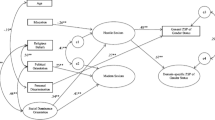Abstract
An Opposing Process Model outlining the pathways through which individual differences in Benevolent Sexism (BS) simultaneously enhance and attenuate support for gender equality of income and employment opportunity is presented. Results from a New Zealand electoral sample (N = 336) indicated that BS predicted Hostile Sexism (HS), and thus indirectly opposition toward gender-related policies (a hierarchy-enhancing effect). For women, BS also directly predicted attitudes toward gender equality in the opposing, supportive direction (a hierarchy-attenuating effect). Analyses of a 9-month longitudinal sample of undergraduate women substantiated these results (Study II; N = 170). In stable societies, the dual opposing effects of BS seem to form a system where hierarchy-enhancing and hierarchy-attenuating processes tend toward homeostasis or equilibrium within the population.



Similar content being viewed by others
References
Aiken, L. S., & West, S. G. (1991). Multiple regression: Testing and interpreting interactions. London: Sage.
Christopher, A. N., & Wojda, M. R. (2008). Social dominance orientation, right-wing authoritarianism, sexism, and prejudice toward women in the workforce. Psychology of Women Quarterly, 32, 65–73.
Glick, P., & Fiske, S. T. (1996). The ambivalent sexism inventory: differentiating hostile and benevolent sexism. Journal of Personality and Social Psychology, 70, 491–512.
Glick, P., Diebold, J., Bailey-Werner, B., & Zhu, L. (1997). The two faces of Adam: ambivalent sexism and polarized attitudes toward women. Personality and Social Psychology Bulletin, 23, 1323–1334.
Glick, P., Fiske, S. T., Mladinic, A., Saiz, J. L., Abrams, D., Masser, B., et al. (2000). Beyond prejudice as simple antipathy: hostile and benevolent sexism across cultures. Journal of Personality and Social Psychology, 79, 763–775.
Glick, P., Fiske, S. T., Masser, B., Manganelli, A. M., Huang, L., Castro, Y. R., et al. (2004). Bad but bold: ambivalent attitudes toward men predict gender inequality in 16 nations. Journal of Personality and Social Psychology, 86, 713–728.
Hu, L.-T., & Bentler, P. M. (1999). Cutoff criteria for fit indexes in covariance structure analysis: conventional criteria versus new alternatives. Structural Equation Modeling, 6, 1–55.
Huddy, L. (2004). Contrasting theoretical approaches to intergroup relations. Political Psychology, 25, 947–967.
Jackman, M. R. (1994). The velvet glove: Paternalism and conflict in gender, class, and race relations. Berkley: University of California Press.
Jost, J. T., & Banaji, M. (1994). The role of stereotyping in system-justification and the production of false consciousness. British Journal of Social Psychology, 22, 1–27.
Jost, J. T., & Kay, A. C. (2005). Exposure to benevolent sexism and complementary gender stereotypes: consequences for specific and diffuse forms of system justification. Journal of Personality and Social Psychology, 88, 498–509.
Kilianski, S. E., & Rudman, L. A. (1998). Wanting it both ways: do women approve of benevolent sexism? Sex Roles, 39, 333–352.
Labour on Women’s Issues. (2005). Summary of policy proposed by The Labour Party of New Zealand in 2005.
O’Connor, B. P. (2000). SPSS and SAS programs for determining the number of components using parallel analysis and Velicer’s MAP test. Behaviour Research Methods, Instruments and Computers, 32, 396–402.
Preacher, K. J., Rucker, D. D., & Hayes, A. F. (2007). Addressing moderated mediation hypotheses: theory, methods, and prescriptions. Multivariate Behavioral Research, 42, 185–227.
Sibley, C. G., & Wilson, M. S. (2004). Differentiating hostile and benevolent sexist attitudes toward positive and negative sexual female subtypes. Sex Roles, 51, 687–696.
Sibley, C. G., Overall, N. C., & Duckitt, J. (2007a). When women become more hostilely sexist toward their gender: the system-justifying effect of benevolent sexism. Sex Roles, 57, 743–754.
Sibley, C. G., Wilson, M. S., & Duckitt, J. (2007b). Antecedents of men’s hostile and benevolent sexism: the dual roles of social dominance orientation and right-wing authoritarianism. Personality and Social Psychology Bulletin, 33, 160–172.
Sibley, C. G., Overall, N. C., Duckitt, J., Perry, R., Milfont, T. L., Khan, S. S., et al. (2009). Your sexism predicts my sexism: perceptions of men’s (but not women’s) sexism affects one’s own sexism over time. Sex Roles, 60, 682–693.
Sidanius, J., & Pratto, F. (1999). Social dominance: An intergroup theory of social hierarchy and oppression. Cambridge: Cambridge University Press.
Statistics New Zealand. (2006). 2006 census of populations and dwellings. Wellington: Statistics New Zealand.
Viki, G. T., & Abrams, D. (2003). Infra-humanization: ambivalent sexism and the attribution of primary and secondary emotions to women. Journal of Experimental Social Psychology, 39, 492–499.
Acknowledgement
Portions of the data in Study 1 were collected as part of Ryan Perry’s honors thesis. We thank Tiane Lee, Irene Frieze and Nickola Overall for helpful comments on an earlier draft of this manuscript.
Author information
Authors and Affiliations
Corresponding author
Rights and permissions
About this article
Cite this article
Sibley, C.G., Perry, R. An Opposing Process Model of Benevolent Sexism. Sex Roles 62, 438–452 (2010). https://doi.org/10.1007/s11199-009-9705-6
Published:
Issue Date:
DOI: https://doi.org/10.1007/s11199-009-9705-6




